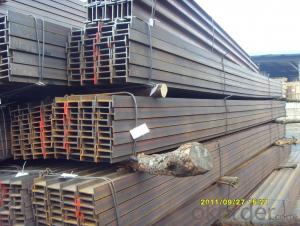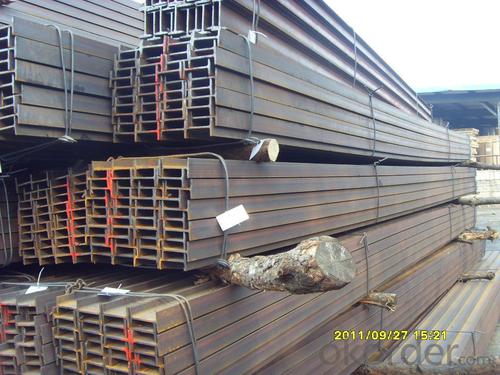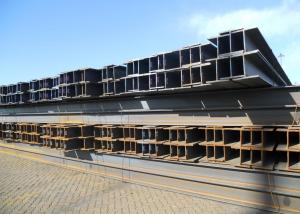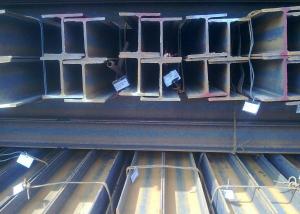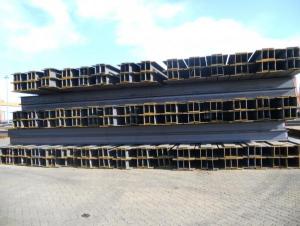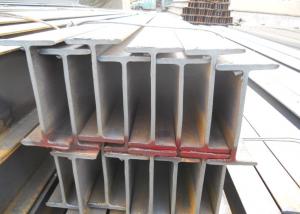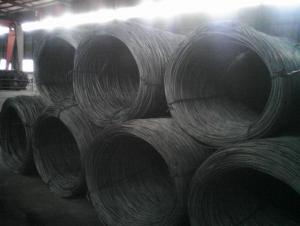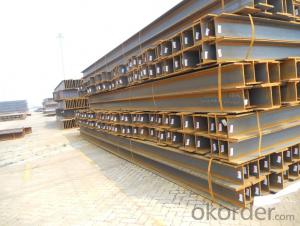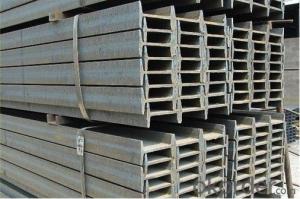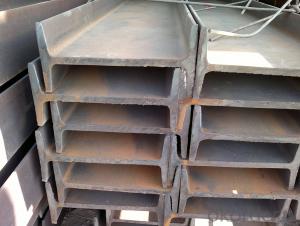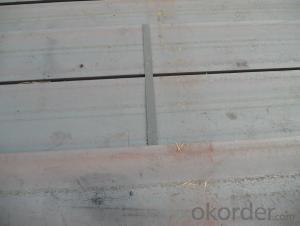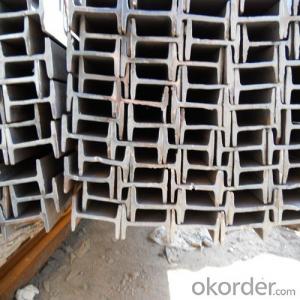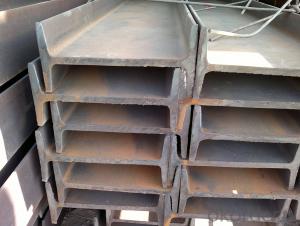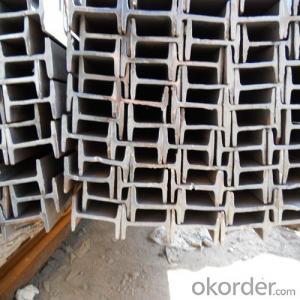H beams/Ibeams GB standard/JIS standard EN standard
- Loading Port:
- Tianjin
- Payment Terms:
- TT OR LC
- Min Order Qty:
- 100 m.t.
- Supply Capability:
- 3000 m.t./month
OKorder Service Pledge
OKorder Financial Service
You Might Also Like
Packaging & Delivery
Packaging Detail:packed in bundle, suitable for sea transport (by container) or According to the clients`requirements
Delivery Detail:According to the actual weight
Specifications
joist steel
high quality and factory price
large inventories
short delievery time
good after-sales service
Country of Origin: China
Mill name: Ningbo Preah Vihear Steel Industry Co., Ltd.
Commodity: H beam
Tolerance: Strictly according to the G/B and JIS standard
Delivery time: within 30days
Price term: CIF/ CFR according to clients requirements
Payment terms: 100%Irrevercable L/C At Sight or TT
Product Description
ACCORDING TO STANDARD: JIS G3192 OR GB/T11263-2005
H beam Section sizenma(mm)Weight (kg/m)
Height×BreadthWeb thichnessFlange thichness
100×1006816.9
125×1256.5923.6
150×15071031.1
175×1757.51140.4
200×20081249.9
250×25091471.8
300×300101593.0
300×3001515105.0
350×3501219134.9
400×4001321171.7
148×1006920.7
194×1506929.9
244×17571143.6
294×20081255.8
340×25091478.1
390×3001016104.6
440×3001118120.8
482×3001115110.8
488×3001118124.9
582×3001217132.8
588×3001220147.0
100×50579.3
125×606813.1
150×755714.0
175×905818.0
198×994.5717.8
200×1005.5820.9
248×1245825.1
250×1256929.0
298×1495.5832.0
300×1506.5936.7
346×1746941.2
350×17571149.4
396×19971156.1
400×20081365.4
446×19981265.1
450×20091474.9
496×19991477.9
500×200101688.1
596×199101592.4
600×2001117103.4
700×3001324181.8
800×3001426206.8
900×3001628240.1
- Q: Can steel H-beams be used in theater stage construction?
- Yes, steel H-beams can be used in theater stage construction. They are commonly used as a structural element in the construction of theater stages due to their strength, durability, and versatility. H-beams provide excellent support, allowing for the creation of large and stable stage platforms, rigging systems, and overhead structures.
- Q: What are the different design guidelines or load tables available for Steel H-Beams?
- There are several design guidelines and load tables available for Steel H-Beams, including those provided by organizations like the American Institute of Steel Construction (AISC), the Canadian Institute of Steel Construction (CISC), and the European Committee for Standardization (EN). These guidelines outline the specifications, dimensions, and load capacities for various sizes and grades of Steel H-Beams, enabling engineers and designers to ensure structural safety and performance.
- Q: Can steel H-beams be used for supporting railway structures?
- Yes, steel H-beams can be used for supporting railway structures. H-beams are commonly used in construction projects for their strength and durability. They are able to support heavy loads and provide stability, making them suitable for railway structures such as bridges, platforms, and support beams. The use of steel H-beams ensures the necessary strength and safety required for railway infrastructure, as they can withstand the weight of trains and the forces exerted on the structures. Additionally, steel H-beams are readily available in various sizes and can be easily fabricated and installed, making them a popular choice for railway construction projects.
- Q: How do steel H-beams perform in earthquake-prone areas?
- Due to their exceptional performance and structural integrity, steel H-beams are widely used in areas prone to earthquakes. The design and construction of H-beams make them highly resistant to the forces generated by seismic events, ensuring the safety of buildings and structures. A significant advantage of steel H-beams is their high strength-to-weight ratio. They are manufactured using high-quality steel, which provides excellent tensile strength and stiffness. This enables them to withstand the lateral and vertical forces exerted by earthquakes without compromising their structural integrity. Furthermore, H-beams have a symmetrical shape that evenly distributes seismic forces throughout the entire structure. This balanced load distribution helps prevent concentrated stress points and reduces the risk of structural failure during an earthquake. Additionally, the wide flanges of H-beams increase resistance to bending and shear forces, further enhancing their performance in seismic events. Steel H-beams also possess excellent ductility, allowing them to deform without breaking. During earthquakes, buildings vibrate and deform due to significant ground shaking. The ductility of steel allows H-beams to absorb and dissipate a significant amount of energy, reducing the risk of sudden failure. This property ensures that H-beams can withstand the dynamic forces during an earthquake and provide a stable structure for the building. Another advantage of steel H-beams is their ease of installation and adaptability. They can be prefabricated off-site, allowing for faster construction and reduced labor costs. Additionally, H-beams can be easily connected and integrated with other structural components, such as concrete or steel columns, to create a robust and earthquake-resistant building system. In conclusion, steel H-beams are a reliable choice for earthquake-prone areas due to their high strength, balanced load distribution, ductility, and ease of installation. Their outstanding performance ensures the safety and stability of structures during seismic events, providing peace of mind to residents and occupants.
- Q: Can Steel H-Beams be used in convention center or exhibition hall construction?
- Yes, Steel H-Beams can be used in convention center or exhibition hall construction. They are commonly used in such projects due to their high strength, durability, and ability to support heavy loads. Steel H-Beams provide structural integrity and can be easily fabricated and installed, making them a reliable choice for large-scale construction projects like convention centers and exhibition halls.
- Q: How do steel H-beams perform in areas with high temperature fluctuations?
- Steel H-beams are renowned for their exceptional strength and durability, which explains their popularity in construction endeavors. Nevertheless, their performance can be somewhat compromised in regions that experience significant temperature fluctuations. Steel possesses a high thermal expansion coefficient, signifying that it expands and contracts considerably in response to temperature changes. In areas with pronounced temperature fluctuations, this phenomenon can induce thermal stress in steel H-beams. The heat causes the beams to expand, while cooling prompts them to contract. This repetitive expansion and contraction can potentially result in structural issues such as warping, bending, or even cracking. To counteract the adverse effects of temperature fluctuations on steel H-beams, engineers and architects adopt several measures. Opting for the appropriate grade of steel is imperative, as certain alloys exhibit superior resistance to thermal stress. Additionally, the design and installation of the beams should account for thermal expansion and contraction. This can be accomplished by integrating expansion joints or allowing for sufficient gaps between different sections of the structure. Moreover, protective coatings can be administered to steel H-beams to bolster their resistance to temperature fluctuations. These coatings act as a shield against heat and cold, thereby reducing the impact of thermal stress on the beams. Regular maintenance and inspection are also vital to identify any indications of damage or deformation caused by temperature fluctuations. In conclusion, while temperature fluctuations can affect steel H-beams to some extent, the appropriate design, material selection, and maintenance practices can mitigate their impact. By considering these factors, steel H-beams can effectively perform in regions with significant temperature variations, ensuring the overall structural integrity of the construction project.
- Q: Can steel H-beams be used for supporting swimming pool enclosures?
- Yes, steel H-beams can be used for supporting swimming pool enclosures. Steel H-beams are commonly used in construction for their strength and durability. They provide excellent support and can withstand heavy loads, making them suitable for supporting swimming pool enclosures. Additionally, steel H-beams are resistant to corrosion, which is crucial in a swimming pool environment where they will be exposed to water and chemicals. However, it is important to consult with a structural engineer or a professional contractor to ensure that the size and specifications of the steel H-beams are appropriate for the specific requirements of the swimming pool enclosure.
- Q: How long do steel H-beams typically last?
- Steel H-beams typically have a very long lifespan and can last for several decades or even longer, depending on various factors such as the quality of the steel, environmental conditions, and maintenance.
- Q: How do steel H-beams perform in high wind areas?
- Steel H-beams have gained a reputation for possessing exceptional strength and durability, making them a favored option for construction in regions with high wind conditions. These beams are specifically designed to withstand extreme weather, including powerful winds, by providing a sturdy and stable framework for buildings and structures. The structural design of steel H-beams allows for the efficient distribution of wind load throughout the entire structure, which minimizes the potential for any damage. The unique shape of the H-beam enables it to bear heavier loads, as it can better resist the bending and twisting forces caused by high winds. This ensures that the beams remain stable, preventing any structural failures or collapses. Moreover, steel H-beams are commonly crafted from high-strength steel alloys, which further enhances their ability to endure high winds. These alloys possess superior tensile strength and elasticity, enabling the beams to flex and absorb the energy from wind gusts without permanently distorting or fracturing. This flexibility aids in dissipating the force of the wind and reducing overall stress on the structure. Additionally, steel H-beams are frequently installed as part of a comprehensive structural system that incorporates other components, including bracing, connectors, and fasteners. These elements work together to enhance the performance of the beams in high wind regions. Properly engineered connections and bracing systems effectively transfer the wind load to the foundation, ensuring the overall stability and integrity of the structure. In conclusion, steel H-beams are well-suited for regions with high wind conditions due to their strength, rigidity, and durability. Their efficient load distribution capabilities, high-strength alloys, and compatibility with other structural components make them a reliable choice for buildings and structures in areas prone to strong winds.
- Q: What are the different types of steel H-beam connections used in industrial buildings?
- There are several different types of steel H-beam connections commonly used in industrial buildings. These connections are designed to provide stability and support to the overall structure. Here are some of the most commonly used types: 1. Welded connection: This is the most common type of connection used in industrial buildings. It involves welding the H-beam to other structural members or plates. Welded connections provide excellent strength and rigidity, making them suitable for heavy-duty applications. 2. Bolted connection: In bolted connections, the H-beam is fastened to other structural members using bolts and nuts. This type of connection allows for easier disassembly and reassembly, making it convenient for buildings that may need to be modified or relocated in the future. 3. Pinned connection: Pinned connections allow for rotation at the joint, providing flexibility to the structure. This type of connection is commonly used in situations where movement or vibration needs to be accommodated, such as bridges or buildings located in earthquake-prone areas. 4. Moment connection: Moment connections are designed to transfer both vertical and horizontal forces between the H-beams and other structural members. These connections provide enhanced stability and resistance against bending moments, making them suitable for structures with high loads or complex geometries. 5. Shear connection: Shear connections are used to transfer shear forces between the H-beams and other structural members. These connections are typically designed to resist lateral loads and provide stability to the structure. The choice of H-beam connection type depends on various factors, including the load requirements, structural design, and construction method. Engineers and designers evaluate these factors to determine the most appropriate connection type for each specific application.
Send your message to us
H beams/Ibeams GB standard/JIS standard EN standard
- Loading Port:
- Tianjin
- Payment Terms:
- TT OR LC
- Min Order Qty:
- 100 m.t.
- Supply Capability:
- 3000 m.t./month
OKorder Service Pledge
OKorder Financial Service
Similar products
Hot products
Hot Searches
Related keywords
